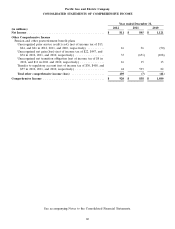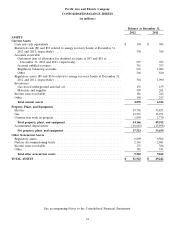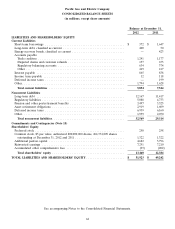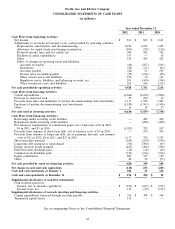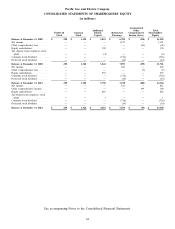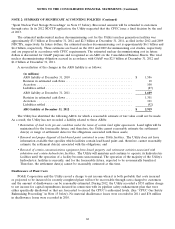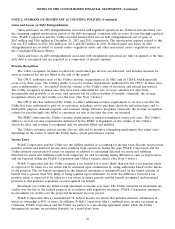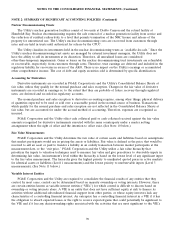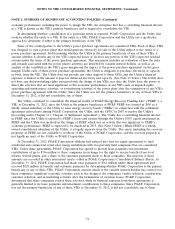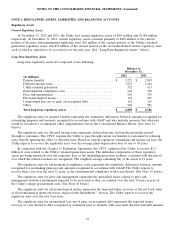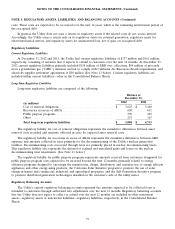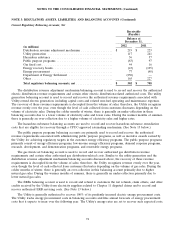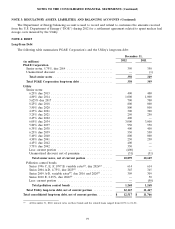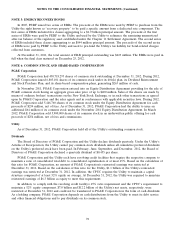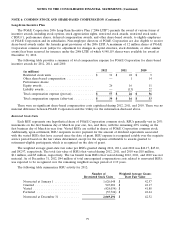PG&E 2012 Annual Report Download - page 74
Download and view the complete annual report
Please find page 74 of the 2012 PG&E annual report below. You can navigate through the pages in the report by either clicking on the pages listed below, or by using the keyword search tool below to find specific information within the annual report.NOTES TO THE CONSOLIDATED FINANCIAL STATEMENTS (Continued)
NOTE 2: SUMMARY OF SIGNIFICANT ACCOUNTING POLICIES (Continued)
Nuclear Decommissioning Trusts
The Utility’s nuclear generation facilities consist of two units at Diablo Canyon and the retired facility at
Humboldt Bay. Nuclear decommissioning requires the safe removal of a nuclear generation facility from service and
the reduction of residual radioactivity to a level that permits termination of the NRC license and release of the
property for unrestricted use. The Utility’s nuclear decommissioning costs are recovered from customers through
rates and are held in trusts until authorized for release by the CPUC.
The Utility classifies its investments held in the nuclear decommissioning trusts as ‘‘available-for-sale.’’ Since the
Utility’s nuclear decommissioning trust assets are managed by external investment managers, the Utility does not
have the ability to sell its investments at its discretion. Therefore, all unrealized losses are considered
other-than-temporary impairments. Gains or losses on the nuclear decommissioning trust investments are refundable
or recoverable, respectively, from customers through rates. Therefore, trust earnings are deferred and included in the
regulatory liability for recoveries in excess of the ARO. There is no impact on the Utility’s earnings or accumulated
other comprehensive income. The cost of debt and equity securities sold is determined by specific identification.
Accounting for Derivatives
Derivative instruments are recorded in PG&E Corporation’s and the Utility’s Consolidated Balance Sheets at
fair value, unless they qualify for the normal purchase and sales exception. Changes in the fair value of derivative
instruments are recorded in earnings or, to the extent that they are probable of future recovery through regulated
rates, are deferred and recorded in regulatory accounts.
The normal purchase and sales exception to derivative accounting requires, among other things, physical delivery
of quantities expected to be used or sold over a reasonable period in the normal course of business. Transactions
which qualify for the normal purchase and sales exception are not reflected in the Consolidated Balance Sheets at
fair value, but are accounted for under the accrual method of accounting. Therefore, expenses are recognized as
incurred.
PG&E Corporation and the Utility offset cash collateral paid or cash collateral received against the fair value
amounts recognized for derivative instruments executed with the same counterparty under a master netting
arrangement where the right of offset and the intention to offset exist. (See Note 10 below.)
Fair Value Measurements
PG&E Corporation and the Utility determine the fair value of certain assets and liabilities based on assumptions
that market participants would use in pricing the assets or liabilities. Fair value is defined as the price that would be
received to sell an asset or paid to transfer a liability in an orderly transaction between market participants at the
measurement date, or the ‘‘exit price.’’ PG&E Corporation and the Utility utilize a fair value hierarchy that
prioritizes the inputs to valuation techniques used to measure fair value and give precedence to observable inputs in
determining fair value. An instrument’s level within the hierarchy is based on the lowest level of any significant input
to the fair value measurement. The hierarchy gives the highest priority to unadjusted quoted prices in active markets
for identical assets or liabilities (Level 1 measurements) and the lowest priority to unobservable inputs (Level 3
measurements). (See Note 11 below.)
Variable Interest Entities
PG&E Corporation and the Utility are required to consolidate the financial results of any entities that they
control. In most cases, control can be determined based on majority ownership or voting interests. However, there
are certain entities known as variable interest entities (‘‘VIEs’’) for which control is difficult to discern based on
ownership or voting interests alone. A VIE is an entity that does not have sufficient equity at risk to finance its
activities without additional subordinated financial support from other parties, or whose equity investors lack any
characteristics of a controlling financial interest. An enterprise has a controlling financial interest in a VIE if it has
the obligation to absorb expected losses or the right to receive expected gains that could potentially be significant to
the VIE and if it has any decision-making rights associated with the activities that are most significant to the VIE’s
70


